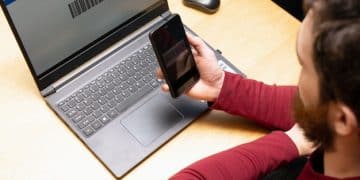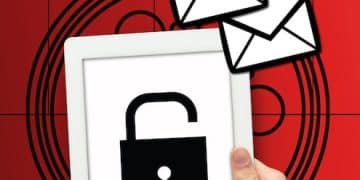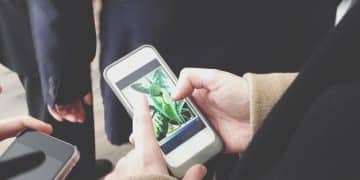Secure Your Finances: Set Up 2FA on US Bank Accounts in Minutes (2025)

Setting up two-factor authentication (2FA) on your US bank accounts is crucial for enhancing security against unauthorized access; this guide provides a quick, step-by-step process to implement 2FA in under 15 minutes, ensuring your financial information remains protected in 2025.
Want to bolster the security of your US bank accounts quickly and effectively? Discover how to set up two-factor authentication on your US bank accounts in under 15 minutes (2025 update), offering an essential layer of protection against fraud and unauthorized access.
Why Two-Factor Authentication is a Must for Your Bank Accounts
In an era where cyber threats are increasingly sophisticated, relying solely on a password to protect your bank accounts is no longer sufficient. Two-factor authentication (2FA) provides an added layer of security, significantly reducing the risk of unauthorized access, even if your password is compromised.
Understanding the Risks of Password-Only Security
Using only a password leaves your accounts vulnerable to various cyberattacks, including phishing, brute-force attacks, and malware. These methods can expose your sensitive financial information, leading to potential fraud and identity theft. Implementing 2FA acts as a strong deterrent against these threats.
The Benefits of Adding an Extra Layer of Security
Two-factor authentication (2FA) reduces the likelihood of account breaches because it requires a second verification method beyond your password. This means that even if hackers obtain your password, they still need access to your second factor, such as your phone or email, to gain entry.
- Enhanced Protection: Significantly lowers the risk of unauthorized account access.
- Peace of Mind: Knowing your financial information is more secure provides reassurance.
- Quick Setup: Many banks offer easy-to-follow instructions for setting up 2FA.
- Compliance: Some banks may require 2FA for online banking to meet security standards.
By implementing 2FA, you are taking a proactive step to safeguard your financial well-being. It’s a straightforward process that offers substantial protection and peace of mind in today’s digital landscape.
In conclusion, enabling 2FA is a vital security measure for your US bank accounts, adding a robust layer of protection against unauthorized access and potential financial fraud.
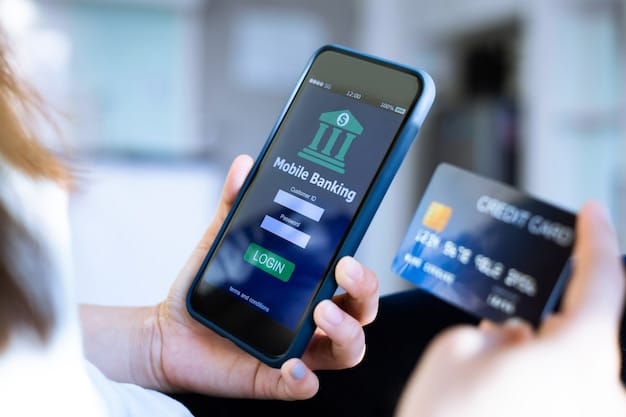
Step-by-Step Guide: Setting Up 2FA on Your US Bank Accounts
Setting up two-factor authentication on your US bank accounts is a straightforward process that can be completed in a matter of minutes. This guide will walk you through the general steps, though the exact process may vary slightly depending on your bank.
Logging into Your Online Banking Portal
Begin by logging into your online banking portal through your bank’s website or mobile app. Ensure you are using a secure connection and avoid using public Wi-Fi networks, as these can be vulnerable to interception.
Navigating to the Security Settings
Once logged in, navigate to the security settings section. This is typically found under “Settings,” “Profile,” or “Security.” Look for options related to authentication methods or security preferences. Each bank has a slightly different interface, so take your time reviewing the options.
Selecting Two-Factor Authentication Options
Within the security settings, you will find options for enabling two-factor authentication. Banks commonly offer several 2FA methods, allowing you to choose the one that best suits your needs:
- SMS Verification: Receive a one-time passcode (OTP) via text message.
- Email Verification: Receive an OTP via email.
- Authenticator App: Use an app like Google Authenticator or Authy to generate OTPs.
- Hardware Token: Use a physical device to generate OTPs.
Choose the method that is most convenient and secure for you. Authenticator apps and hardware tokens are generally considered more secure than SMS or email verification due to the risk of SIM swapping or email hacking.
Completing the Setup Process
After selecting your preferred 2FA method, follow the on-screen instructions to complete the setup process. This may involve verifying your phone number or email address, or scanning a QR code with your authenticator app. Make sure to save any recovery codes or backup methods provided by your bank, as these will be essential if you lose access to your primary 2FA device.
By following these steps, you can quickly and effectively set up two-factor authentication on your US bank accounts, providing a robust layer of security against unauthorized access.
Choosing the Right 2FA Method for Your Needs
Selecting the right two-factor authentication method is crucial for ensuring both security and convenience. Each 2FA method has its own strengths and weaknesses, so it’s important to consider your individual needs and preferences.
SMS Verification: Pros and Cons
SMS verification is a widely used 2FA method that sends a one-time passcode (OTP) to your mobile phone via text message. It’s convenient and easy to use, but it’s also considered less secure than other methods due to the risk of SIM swapping and SMS interception.
Authenticator Apps: Enhanced Security
Authenticator apps, such as Google Authenticator, Authy, or Microsoft Authenticator, generate OTPs that are stored locally on your device. These apps are more secure than SMS verification because they aren’t susceptible to SIM swapping or SMS interception. Another advantage of the app is the ability to generate codes even without internet connection.
Email Verification: A Less Secure Option
Email verification sends an OTP to your email address. While it’s convenient, it is considered less secure than authenticator apps or hardware tokens because email accounts can be hacked. Therefore, it is recommended to enable security for your main email account too.
Ultimately, the choice of 2FA method depends on your individual needs and risk tolerance. Consider the pros and cons of each method and choose the one that offers the best balance of security and convenience for your situation. For maximum security, authenticator apps are generally recommended.
What to Do If You Lose Access to Your 2FA Device
Losing access to your 2FA device can be a stressful situation, but most banks have established procedures to help you regain access to your account. Acting quickly and following your bank’s recovery process is essential.
Contacting Your Bank’s Customer Support
The first step is to contact your bank’s customer support. Explain that you have lost access to your 2FA device and need assistance regaining access to your account. Be prepared to provide identification and answer security questions to verify your identity.
Using Recovery Codes or Backup Methods
When you initially set up 2FA, your bank may have provided recovery codes or backup methods. If you saved these codes, you can use them to disable 2FA and regain access to your account. Follow your bank’s instructions for using recovery codes.
Disabling 2FA Temporarily
In some cases, your bank may allow you to temporarily disable 2FA to regain access to your account. This typically requires providing additional verification and may involve a waiting period. Once you have regained access, you can set up 2FA again with a new device.
- Contact your bank immediately if you lose your 2FA device.
- Provide identification to verify your identity.
- Use recovery codes or backup methods if available.
- Follow your bank’s instructions carefully.
By taking these steps, you can minimize the disruption caused by losing access to your 2FA device and quickly regain control of your bank account.
Staying Safe: Best Practices for 2FA Security
While two-factor authentication significantly enhances the security of your bank accounts, it’s important to follow best practices to maximize its effectiveness and protect yourself from potential threats.
Keeping Your Recovery Codes Secure
When you set up 2FA, your bank provides you with recovery codes. Store these codes in a safe and accessible place, such as a password manager or a physical document stored securely. These codes are crucial for regaining access to your account if you lose your 2FA device.
Being Wary of Phishing Attempts
Phishing attempts can trick you into revealing your 2FA codes or other sensitive information. Be cautious of suspicious emails or messages that ask for your 2FA codes. Banks will never ask for your 2FA codes directly. Always verify the legitimacy of any communication before providing information.
Regularly Reviewing Your Security Settings
Periodically review your bank’s security settings to ensure that your 2FA method is still active and that your contact information is up to date. Consider enabling additional security features, such as account alerts or transaction monitoring, to further protect your account.
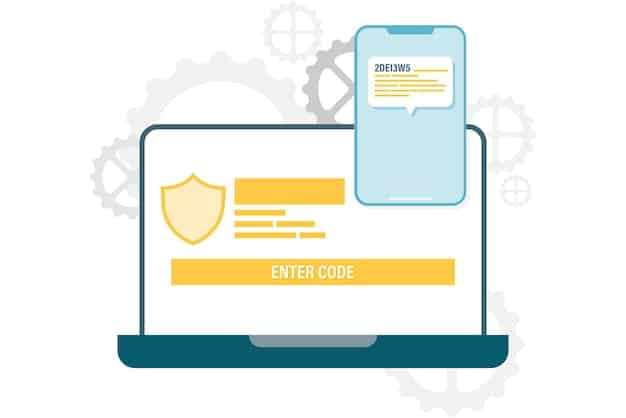
By following these best practices, you can ensure that your 2FA setup remains secure and effective, helping to protect your bank accounts from unauthorized access and potential fraud.
The Future of Banking Security: What to Expect in 2025
As technology evolves, so do the methods used to secure our financial information. Looking ahead to 2025, we can anticipate several advancements in banking security, including more sophisticated 2FA methods and enhanced fraud detection systems.
Biometric Authentication
Biometric authentication, such as fingerprint scanning, facial recognition, and voice recognition is likely to become more widespread. These methods offer a high level of security and convenience, making them an attractive alternative to traditional passwords and OTPs.
AI-Powered Fraud Detection
Artificial intelligence (AI) is already playing a significant role in fraud detection, and its capabilities are only expected to grow. AI algorithms can analyze transaction patterns and identify suspicious activities in real-time, helping to prevent fraud before it occurs.
Blockchain Technology
Blockchain technology has the potential to revolutionize banking security by providing a secure and transparent ledger of transactions. Blockchain-based systems can reduce the risk of fraud and enhance the integrity of financial data.
While these advancements promise to enhance banking security, it is important to stay informed about the latest threats and vulnerabilities. Regularly updating your security practices and staying vigilant against phishing attempts are essential for protecting your financial information in the digital age.
| Key Point | Brief Description |
|---|---|
| 🔑 Enable 2FA | Add an extra layer of security to your US bank accounts. |
| 📱 Choose App | Authenticator apps are more secure than SMS. |
| 🚨 Phishing Aware | Never share 2FA codes via email or messages. |
| 💾 Backup Codes | Store recovery codes safely to regain access. |
Frequently Asked Questions (FAQ)
▼
Two-factor authentication (2FA) is an extra layer of security for your online accounts. It requires you to provide two different verification factors when logging in, such as a password and a code from your phone.
▼
Using 2FA significantly reduces the risk of unauthorized access to your bank accounts. Even if someone knows your password, they will also need access to your second factor, like your phone, to log in.
▼
Most banks provide recovery codes or backup methods for regaining access to your account if you lose your 2FA device. Contact your bank’s customer support for assistance and have ID available.
▼
While SMS verification is convenient, it’s less secure than authenticator apps due to the risk of SIM swapping or SMS interception. Consider using an authenticator app for enhanced security.
▼
Yes, you can disable 2FA through your bank’s security settings, but it’s strongly recommended to keep it enabled for better security. Disabling 2FA increases vulnerability to unauthorized access.
Conclusion
Implementing two-factor authentication on your US bank accounts is a simple yet highly effective way to protect your financial information. By following the steps outlined in this guide, you can enhance your security in under 15 minutes and enjoy greater peace of mind knowing that your accounts are better protected against unauthorized access.

